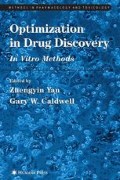Abstract
The Caco-2 cell culture model is used to determine the absorption potentials of drug candidates and the transport and metabolism mechanisms of drugs and dietary chemicals. The Food and Drug Administration (FDA) recognized the model system as useful in classifying a compound’s absorption characteristics in the Biopharmaceutics Classification System. In addition to its usefulness as an absorption model, the Caco-2 cells are useful for studying the metabolism of drugs. More recently, they have been used to determine the efflux mechanisms of phase II conjugates of drugs and natural products. However, Caco-2 cells do not always express appropriate amounts of transporters or enzymes, which may introduce bias in the determination of their transport via a carriermediated process or their metabolism via a particular pathway. Additional genetic manipulation of the Caco-2 cells will be needed to further advance the utility of this model in the drug development process and to ultimately establish this model as the “gold standard” for studying intestinal disposition of drugs.
Access this chapter
Tax calculation will be finalised at checkout
Purchases are for personal use only
References
Hidalgo, I. J., Raub, T. J., and Borchardt, R. T. (1989) Characterization of the human colon carcinoma cell line (Caco-2) as a model system for intestinal epithelial permeability. Gastroenterology 96, 736–749.
Dix, C. J., Hassan, I. F., Obray, H. Y., Shah, R., and Wilson, G. (1990) The transport of vitamin B12 through polarized monolayers of Caco-2 cells. Gastroenterology 98(5, Pt. 1), 1272–1279.
Hidalgo, I. J. (2001) Assessing the absorption of new pharmaceuticals. Curr. Top. Med. Chem. 1, 385–401.
Artursson, P., Palm, K., and Luthman, K. (2001) Caco-2 monolayers in experimental and theoretical predictions of drug transport. Adv. Drug Deliv. Rev. 46, 27–43.
Watanabe, K., Sawano, T., Endo, T., Sakata, M., and Sato, J. (2002) Studies on intestinal absorption of sulpiride (2): transepithelial transport of sulpiride across the human intestinal cell line Caco-2. Biol. Pharm. Bull. 25, 1345–1350.
Terao, T., Hisanaga, E., Sai, Y., Tamai, I., and Tsuji, A. (1996) Active secretion of drugs from the small intestinal epithelium in rats by P-glycoprotein functioning as an absorption barrier. J. Pharm. Pharmacol. 48, 1083–1089.
Karlsson, J., Kuo, S. M., Ziemniak, J., and Artursson, P. (1993) Transport of celiprolol across human intestinal epithelial (Caco-2) cells: mediation of secretion by multiple transporters including P-glycoprotein. Br. J. Pharmacol. 110, 1009–1016.
Liang, E., Proudfoot, J., and Yazdanian, M. (2000) Mechanisms of transport and structure-permeability relationship of sulfasalazine and its analogs in Caco-2 cell monolayers. Pharm. Res. 17, 1168–1174.
Hu, M., Roland, K., Ge, L., Chen, L., Tyle, P., and Roy, S. (1998) Determination of absorption characteristics of AG337, a novel thymidylate synthase inhibitor, using a perfused rat intestinal model. J. Pharm. Sci. 87, 886–890.
Ruiz-Garc’a, A., Lin, H., Plá-Delfina, J. M., and Hu, M. (2002) Kinetic characterization of secretory transport of a new ciprofloxacin derivative (CNV97100) across Caco-2 cell monolayers. J. Pharm. Sci. 91, 2511–2519.
Hu, M. and Borchardt, R. T. (1992) Transport of a large neutral amino acid in a human intestinal epithelial cell line (Caco-2): uptake and efflux of phenylalanine. Biochim. Biophys. Acta 1135, 233–244.
Hu, M., Zheng, L., Chen, J., Liu, L., Zhu, Y., Dantzig, A. H., et al. (1995) Mechanisms of transport of quinapril in Caco-2 cell monolayers: comparison with cephalexin. Pharm. Res. 12, 1120–1125.
Hu, M., Zheng, L., Chen, J., Liu, L., Li, Y., Dantzig, A. H., et al. (1995) Peptide transporter function and prolidase activities in Caco-2 cells: a lack of coordinated expression. J. Drug Target. 3, 291–300.
Artursson, P. and Borchardt, R. T. (1997) Intestinal drug absorption and metabolism in cell cultures: Caco-2 and beyond. Pharm. Res. 14, 1655–1658.
Chikhale, P. J. and Borchardt, R. T. (1994) Metabolism of L-alpha-methyldopa in cultured human intestinal epithelial (Caco-2) cell monolayers: comparison with metabolism in vivo. Drug Metab. Dispos. 22, 592–600.
Hu, M., Chen, J., Tran, D., Zhu, Y., and Leonardo, G. (1994) The Caco-2 cell monolayers as an intestinal metabolism model: metabolism of dipeptide Phe-Pro. J. Drug Target 2, 79–89.
Hu, M., Chen, J., and Lin, H. (2003) Disposition of flavonoids via recycling: mechanistic studies of disposition of apigenin in the Caco-2 cell culture model. J. Pharmacol. Exp. Ther. 307, 314–321.
Chen, J., Lin, H., and Hu, M. (2003) Metabolism of flavonoids via enteric recycling: role of intestinal disposition. J. Pharmacol. Exp. Ther. 304, 1228–1235.
Pontier, C., Pachot, J., Botham, R., Lenfant, B., and Arnaud, P. (2001) HT29-MTX and Caco-2/TC7 monolayers as predictive models for human intestinal absorption: role of the mucus layer. J. Pharm. Sci. 90, 1608–1619.
Walter, E., Janich, S., Roessler, B. J., Hilfinger, J. M., and Amidon, G. L. (1996) HT29-MTX/Caco-2 cocultures as an in vitro model for the intestinal epithelium: in vitro-in vivo correlation with permeability data from rats and humans. J. Pharm. Sci. 85, 1070–1076.
Crespi, C. L., Penman, B. W., and Hu, M. (1996) Development of Caco-2 cells expressing high levels of cDNA-derived cytochrome P4503A4. Pharm. Res. 13, 1635–1641.
Schmiedlin-Ren, P., Thummel, K. E., Fisher, J. M., Paine, M. F., Lown, K. S., and Watkins, P. B. (1997) Expression of enzymatically active CYP3A4 by Caco-2 cells grown on extracellular matrix-coated permeable supports in the presence of 1-alpha,2,5-dihydroxyvitamin D3. Mol. Pharmacol. 51, 741–754.
Hu, M., Li, Y., Penman, B. W., Huang, S. M., Thummel, K., and Crespi, C. L. (1999) Morphological and metabolic characterization of Caco-2 cells expressing high levels of cDNA-derived cytochrome P4503A4. Pharm. Res. 16, 1352–1359.
Author information
Authors and Affiliations
Editor information
Editors and Affiliations
Rights and permissions
Copyright information
© 2004 Humana Press Inc., Totowa, NJ
About this protocol
Cite this protocol
Hu, M., Ling, J., Lin, H., Chen, J. (2004). Use of Caco-2 Cell Monolayers to Study Drug Absorption and Metabolism. In: Yan, Z., Caldwell, G.W. (eds) Optimization in Drug Discovery. Methods in Pharmacology and Toxicology. Humana Press. https://doi.org/10.1385/1-59259-800-5:019
Download citation
DOI: https://doi.org/10.1385/1-59259-800-5:019
Publisher Name: Humana Press
Print ISBN: 978-1-58829-332-9
Online ISBN: 978-1-59259-800-7
eBook Packages: Springer Protocols

